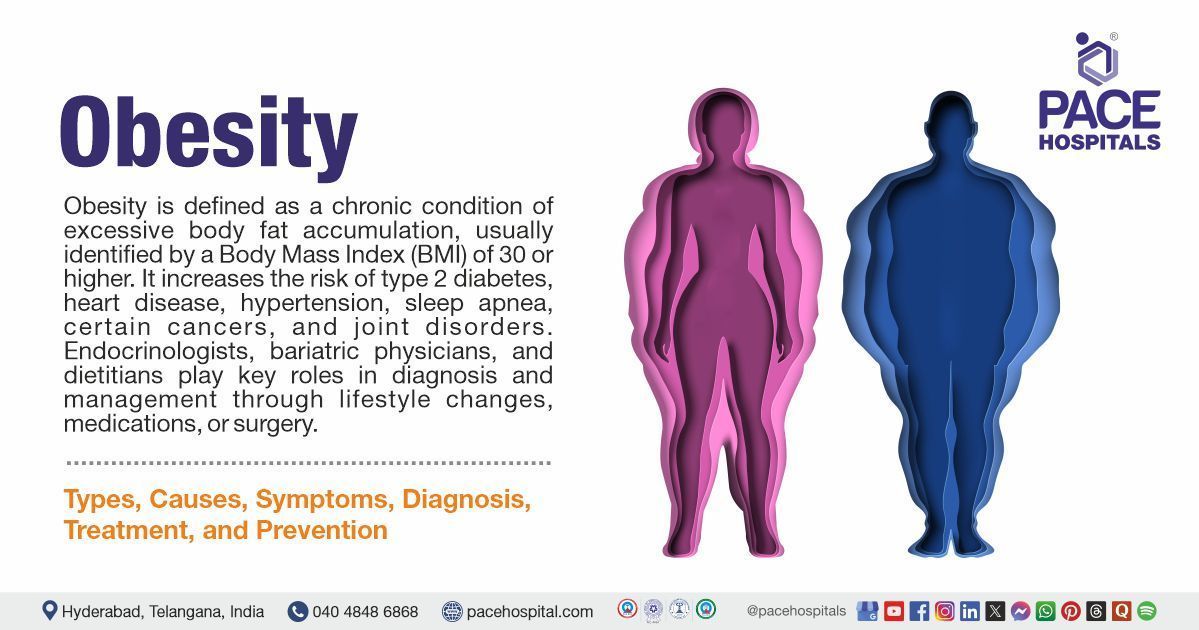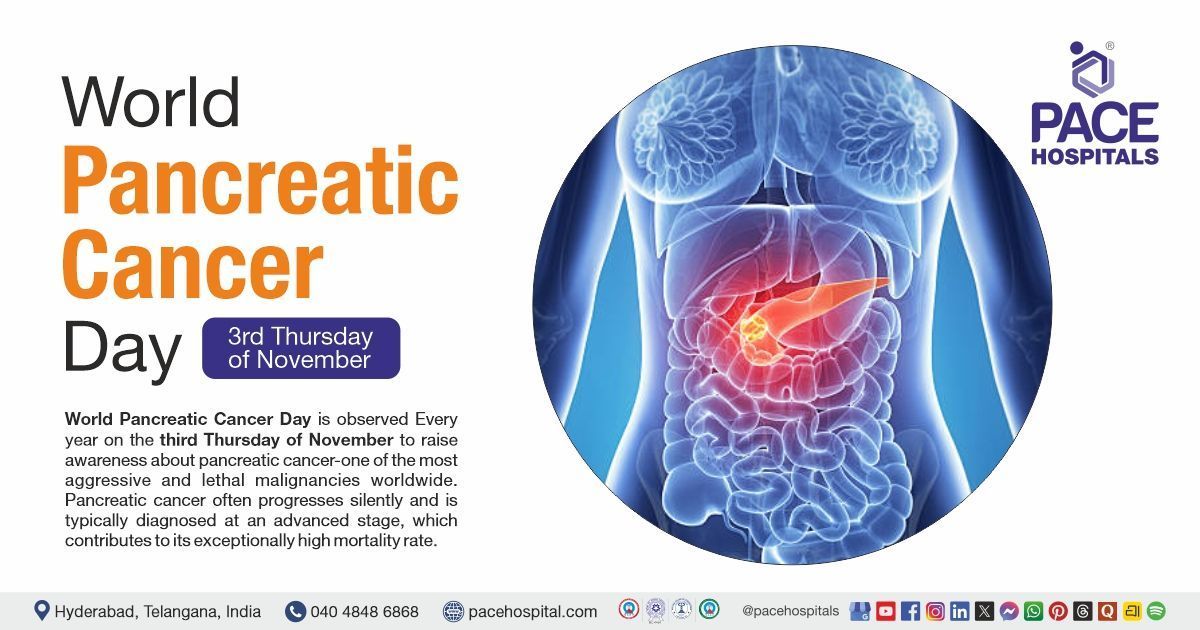Obesity - Types, Causes, Symptoms, Diagnosis and Treatment
PACE Hospitals
Overview | Prevalence | Types | Causes | Risk Factors | Symptoms | Complications | Diagnosis | Treatment | Prevention | Overweight vs Obese | FAQs | When to consult a Doctor
Obesity definition
Obesity is a chronic medical condition defined by an excessive buildup of body fat that negatively affects health. Usually, it happens when a person takes in more calories than they expend, leading to fat storage, which is primarily measured by the Body Mass Index (BMI) of 30 or higher. Obesity is associated with serious health complications, including type 2 diabetes, heart disease, high blood pressure (hypertension), sleep apnea, certain cancers, and joint disorders. Common symptoms include increased body weight, fatigue, shortness of breath, and joint pain. Obesity is managed by specialists such as endocrinologists, dietitians, and bariatric physicians who focus on weight-related hormones, nutrition, and metabolic health. Treatment involves lifestyle alterations such as diet, exercise, medications, and surgery (if needed) to reduce risks and improve overall quality of life.
Obesity meaning
The term "obesity" is derived from the Latin word "obesus," which means "having eaten until fat." Medically, obesity is defined as an abnormal or excessive accumulation of fat that impairs health. It is generally measured using the Body Mass Index (BMI), which is calculated by dividing a person’s weight in kilograms (kg) by the square of their height in meters (m²).
Prevalence of Obesity
Obesity prevalence worldwide
Obesity prevalence is alarmingly high globally, with around one out of every eight people suffering. Over 250 crore adults aged 18 years or older were categorised as overweight, with about 89 crores being obese. This equates to roughly 43% of the adult population being overweight and 16% obese. The trend is similarly concerning among children and adolescents. 3.5 crores children under the age of five were overweight, while among those aged 5-19 years, 39 crores were overweight, of whom 16 crores were classified as obese. Particularly, worldwide obesity rates have more than doubled in adults and nearly quadrupled in adolescents since 1990, highlighting a significant and persistent public health challenge. The prevalence tends to be higher in urban and high-income regions but affects all socioeconomic groups worldwide.
Prevalence of obesity in India
Obesity prevalence in India is rapidly increasing, especially in metropolitan areas, with around 28 crore Indians classified as overweight or obese. Childhood obesity is also at higher rates, with around 1.4 crore children categorised as obese, ranking India among the countries with the most significant number of obese children.

Types of Obesity
Obesity is a complex disorder that is characterised in several ways based on fat distribution, BMI, underlying causes, age of onset, and clinical impact. Understanding the types helps in effective diagnosis, treatment, and prevention strategies. Obesity can be classified based on various criteria:
Based on fat distribution
Obesity is classified based on where fat is predominantly distributed in the body. The following are the 2 subtypes:
- Abdominal obesity or central obesity: Excess fat builds up around the abdomen and upper body in this type. Often referred to as "apple-shaped" obesity, it is more common in males. As visceral fat surrounds vital organs, a higher risk of cardiac diseases, metabolic syndrome and type-2 diabetes mellitus is closely associated with central obesity as visceral fat surrounds vital organs.
- Peripheral obesity or gynoid obesity: In this type, fat is stored primarily in the hips, thighs, and buttocks, giving a "pear-shaped" appearance. It is more common in females and is usually considered to have a lower risk of metabolic complications compared to central obesity.
Based on BMI (Body Mass Index)
Obesity is most categorised by BMI; this uses weight and height variables in a simple calculation. The World Health Organisation (WHO) provides the following classification:
- Overweight: BMI 25.0–29.9 kg/m²
- Class I obesity (moderate): BMI 30.0–34.9 kg/m²
- Class II obesity (severe): BMI 35.0–39.9 kg/m²
- Class III obesity (morbid/extreme): BMI ≥ 40.0 kg/m²
For asian populations, lower BMI thresholds may be used due to higher fat content at lower BMIs.
Based on the cause
Obesity is classified based on causes into two main subtypes:
- Primary obesity: It is also known as exogenous obesity, and the primary cause of this most prevalent type of obesity is the imbalance between caloric intake and expenditure. Physical inactivity, poor diet, and unhealthy lifestyle habits are the main contributing factors.
- Secondary obesity: It is also known as endogenous obesity; this type results from underlying medical conditions or the use of certain medications. Common causes include:
- Endocrine disorders like hypothyroidism and Cushing`s syndrome
- Polycystic ovarian syndrome (PCOS).
- Medication-induced obesity, such as steroids and antipsychotics.
Based on the Age of Onset
Classification based on age of onset helps differentiate obesity into:
- Childhood Onset Obesity: This begins in early life and is often influenced by genetics, poor dietary patterns, and low physical activity. It is quite possible to remain into adulthood and has been linked to the early development of chronic diseases.
- Adult-Onset Obesity: This typically occurs due to lifestyle factors like sedentary behaviour, poor diet, and stress. Metabolic rate slows with age, making weight gain more likely in adulthood.
Based on clinical impact
Obesity can be classified into two types based on clinical impact:
- Pre-clinical obesity: It is an emerging concept referring to individuals with excess body fat who do not yet show signs of organ damage or metabolic complications and highlights the importance of early intervention to prevent disease progression.
- Clinical obesity: In this type of obesity, measurable health impairments like insulin resistance, fatty liver disease, heart problems, or respiratory problems occur.
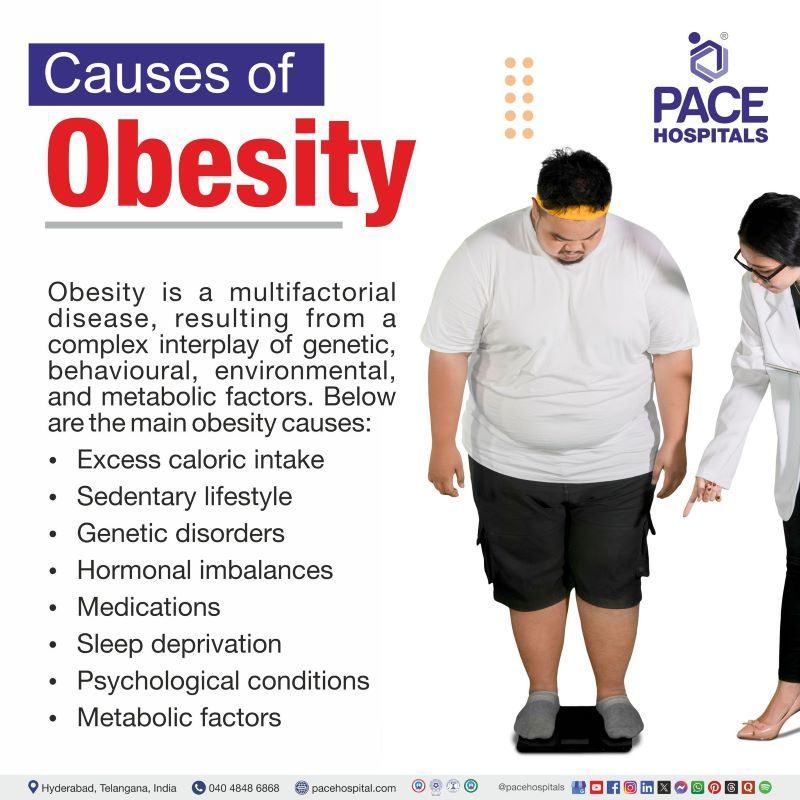
Causes of Obesity
Obesity is a multifactorial disease, resulting from a complex interplay of genetic, behavioural, environmental, and metabolic factors.
Below are the main obesity causes:
- Excess caloric intake
- Sedentary lifestyle
- Genetic disorders
- Hormonal imbalances
- Medications
- Sleep deprivation
- Psychological conditions
- Metabolic factors
Excess caloric intake: Regular intake of more calories than the body can burn leads to the surplus energy being stored as fat, gradually causing weight gain. Over time, the body adapts to a high-calorie environment, increasing fat cell size and number. Processed foods and sugary drinks often worsen this by packing high calories with little satiety.
Sedentary lifestyle: Low physical activity means a few calories are used, contributing to fat accumulation, especially when combined with high-calorie diets. Modern lifestyles with screen time, desk jobs and reduced outdoor activities worsen the issue. This inactivity reduces muscle mass, which further lowers the resting metabolic rate.
Genetic disorders: Genetic factors like leptin deficiency or rare syndromes (Prader-Willi syndrome) can directly disturb appetite and metabolism, making weight control more difficult. Individuals with these conditions may feel constantly hungry or have slower fat burning. Genetics may also influence where fat is stored and how effectively calories are used.
Hormonal imbalances: Disorders such as hypothyroidism, Cushing's syndrome, and polycystic ovary syndrome (PCOS) can disturb how the body regulates fat storage and hunger. Hormones such as cortisol, thyroid hormones and insulin directly affect weight regulation. Even with diet control, weight loss may be difficult until the underlying condition is managed.
Medications: Some drugs, including steroids, antidepressants, and antipsychotics, may increase hunger or slow metabolism, causing unintended weight gain. They may also promote fluid retention or alter how fat is distributed in the body. Individuals often find it difficult to lose weight while on these medications despite healthy habits.
Sleep deprivation: Not getting enough or good-quality sleep changes hunger hormones, often leading to weight gain and overeating over time. Lack of sleep raises ghrelin (hunger hormone) and lowers leptin (satiety hormone). It also increases cravings for high-sugar, high-fat foods due to fatigue and stress.
Psychological conditions: Disorders such as binge eating, chronic stress, or depression lead to emotional overeating and poor dietary choices, further increasing obesity risk. Food is usually used as a coping mechanism to deal with negative emotions. Mental health struggles can also reduce motivation to exercise or plan balanced meals.
Metabolic factors: A naturally lower basal metabolic rate or altered fat storage mechanisms mean the body burns fewer calories at rest, promoting fat buildup. Some individuals genetically burn calories more slowly, even while at rest. It makes it harder to create a calorie deficit needed for weight loss without strict dietary and activity changes.
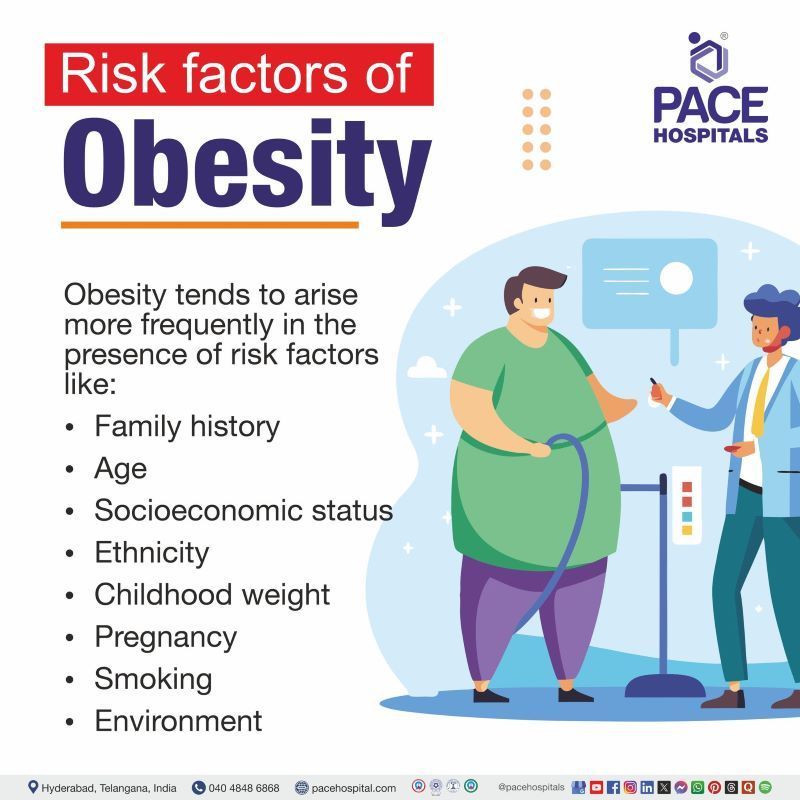
Obesity Risk Factors
A comprehensive understanding of obesity risk factors, including genetics, social environment, lifestyle, and healthcare access, is crucial for effective prevention and public health planning. These interrelated factors have a potential effect on obesity. Timely recognition and modification of these risks can help reduce obesity rates and their global health impact.
The following are the risk factors that include:
- Family history
- Age
- Socioeconomic status
- Ethnicity
- Childhood weight
- Pregnancy
- Smoking
- Environment
Family history: Having relatives with obesity raises risk, likely due to shared genes and lifestyle habits. Genetics affects how the body stores fat, the appetite, and how quickly an individual burns calories. Children often adopt the eating and activity patterns of their household, reinforcing weight issues.
Age: Individuals' metabolism naturally slows down as they become older, and they tend to be less active. Muscle mass tends to decrease, which lowers calorie requirements and facilitates weight gain. Hormonal fluctuations might also affect the place and manner of fat storage.
Socioeconomic status: Maintaining a healthy weight is more challenging when there is limited access to nutritious foods or safe areas for exercise. Communities with lower incomes might rely more on cheap, processed foods that are high in calories but low in nutrients. Emotional eating and sedentary behaviour can also result from stress brought on by financial uncertainty.
Ethnicity: Obesity rates are greater among some ethnic groups, including Hispanic and African-American communities. This results from a combination of socioeconomic inequalities, genetic predisposition, and cultural eating customs. But systemic obstacles to wellness and healthcare resources may increase the risk.
Childhood weight: Being overweight during childhood or adolescence significantly raises the risk of adult obesity. Low activity levels, early eating patterns and larger fat cell development often persist into adulthood. Obese children are also more likely to experience metabolic and hormonal imbalances early on.
Pregnancy: Weight gained during pregnancy that is not lost afterwards can lead to long-term obesity. Hormonal shifts, increased appetite, and reduced postnatal activity can all contribute to this. Multiple pregnancies without full recovery may compound weight retention over time.
Smoking: After quitting smoking, many people gain weight due to increased appetite and altered metabolism. Nicotine suppresses hunger and raises metabolism, so stopping can lead to a calorie surplus. Food may also become a substitute coping mechanism, especially during cravings or stress.
Environment: Living in areas without parks, sidewalks, or healthy food options limits chances for an active, balanced lifestyle. Fast food outlets may outnumber grocery stores, and unsafe neighbourhoods can discourage outdoor activity. This "obesogenic environment" makes healthy living more difficult despite personal effort.
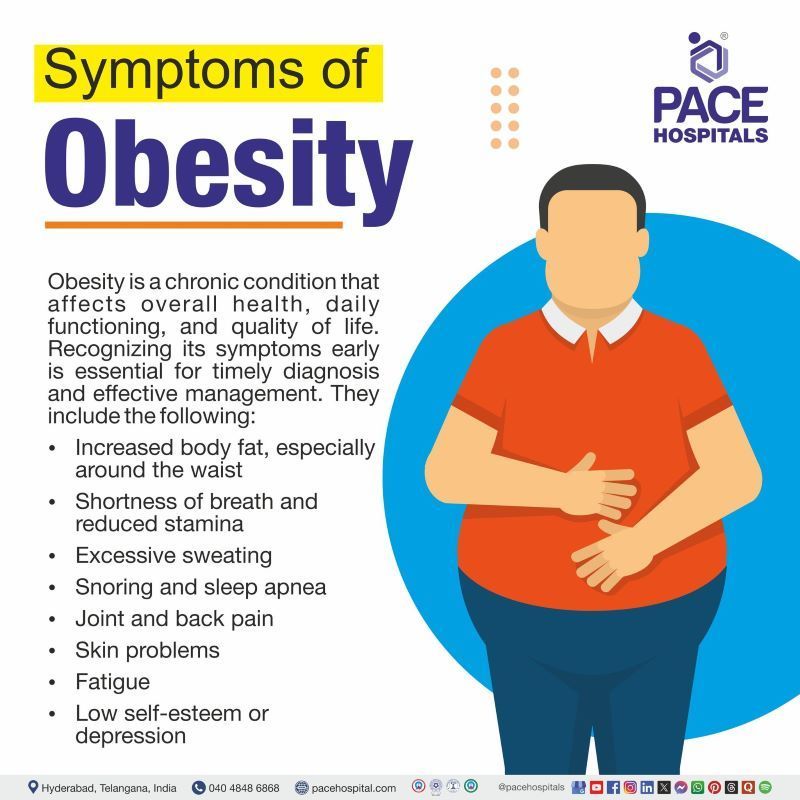
Obesity Symptoms
While obesity may not always present with immediate or specific symptoms, it significantly affects physical, psychological, and metabolic health over time. The accumulation of excess body fat disturbs normal bodily functions and increases the risk of various comorbidities. Recognizing the symptoms related to obesity is essential for early identification and intervention.
The common symptoms of obesity and their clinical implications are given below:
- Increased body fat, especially around the waist
- Shortness of breath and reduced stamina
- Excessive sweating
- Snoring and sleep apnea
- Joint and back pain
- Skin problems
- Fatigue
- Low self-esteem or depression
Increased body fat, especially around the waist: An abnormal accumulation of body fat, particularly in the abdominal region, is a hallmark of obesity. Central or visceral fat is especially concerning as it is closely linked to metabolic disturbances like cardiovascular disease (CVD), type 2 diabetes mellitus, and insulin resistance.
Shortness of breath and reduced stamina: Excess body weight gradually increases the workload on the heart, and lungs often lead to breathlessness even with mild exertion. Decreased physical tolerance and early fatigue during activities are standard, limiting mobility and overall quality of life.
Excessive sweating: Obese people experience profuse sweating due to increased metabolic demand and poor heat dissipation. The body must work harder to regulate its temperature, particularly during physical activity or in warm weather.
Snoring and sleep apnea: Fat deposition around the upper airway and neck can obstruct breathing during sleep, leading to loud snoring and a condition known as obstructive sleep apnea (OSA). OSA is associated with fragmented sleep, daytime fatigue, and increased cardiovascular risks.
Joint and back pain: Excess weight exerts strain on weight-bearing joints like the hip joints, spines, and knees, leading to discomfort, reduced mobility and conditions like osteoarthritis. Back pain is also common due to altered posture and mechanical stress.
Skin problems: Acanthosis nigricans, stretch marks and Skin folds in obese individuals are prone to friction, moisture retention, and infections. Acanthosis nigricans, darkened, velvety skin in body creases, is a marker of insulin resistance; stretch marks result from rapid skin expansion.
Fatigue: Obesity often causes continuous tiredness, hormonal imbalances stemming from poor sleep quality, and the increased physical effort required for daily activities. Fatigue adversely affects productivity and overall well-being.
Low self-esteem or depression: Psychological issues like body image dissatisfaction, social stigma, and discrimination can negatively impact mental health. Many individuals with obesity experience low self-esteem, anxiety, or depression, which may further complicate health behaviours and management.
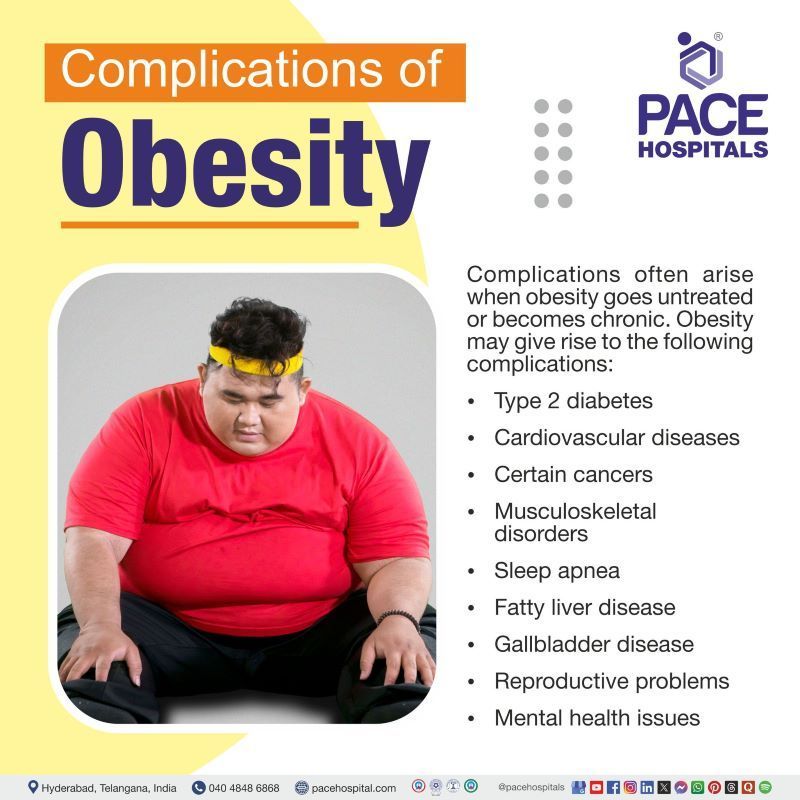
Complications of Obesity
Obesity is a complex, multifaceted disease which affects almost every organ system in the body. Excess body weight raises the likelihood of acquiring a variety of comorbidities, which reduces quality of life and increases mortality. Understanding the spectrum of obesity related problems is critical for healthcare providers to facilitate early intervention and better management options and prevent severe health consequences.
The following are the complications commonly associated with obesity:
- Type 2 diabetes
- Cardiovascular diseases
- Certain cancers
- Musculoskeletal disorders
- Sleep apnea
- Fatty liver disease
- Gallbladder disease
- Reproductive problems
- Mental health issues
Type 2 diabetes: Obesity is the leading risk factor for type 2 diabetes, primarily due to increased insulin resistance caused by excess fat, especially visceral adiposity. Individuals with obesity are up to 12 times more likely to develop type 2 diabetes mellitus, which can lead to complications in several organ systems.
Cardiovascular diseases: Obesity significantly raises the risk of hypertension (high blood pressure), coronary artery disease, heart failure, and stroke. Mechanisms include increased blood pressure, lipid abnormalities, chronic inflammation, and endothelial dysfunction.
Certain cancers: Obesity is linked with a greater incidence of cancers such as breast cancer, colon cancer, and endometrial cancer. Underlying causes include hormonal imbalances, increased inflammation, and altered immune responses.
Musculoskeletal disorders: Excess weight exerts stress on joints, causing osteoarthritis, severe backache, and an increased risk of mobility limitations. Obesity also accelerates cartilage degradation and can cause persistent pain and disability.
Sleep apnea: Fat accumulation around the upper airway and neck increases the risk of obstructive sleep apnea and other respiratory conditions. This leads to recurrent interruptions in breathing during sleep, causing daytime sleepiness and cardiovascular strain.
Fatty liver disease: Obesity is the primary risk factor for non-alcoholic fatty liver disease (NAFLD), progressing in some cases to non-alcoholic steatohepatitis (NASH). Excess fat in the liver induces inflammation and fibrosis, increasing the risk for cirrhosis.
Gallbladder disease: Elevated body weight facilitates the formation of gallstones and bile composition changes, increasing the risk of gallbladder disease. Obese individuals have a higher incidence of cholecystitis and require more cholecystectomies.
Reproductive problems: Obesity can disrupt female and male reproductive hormones, leading to infertility and menstrual irregularities. Women are at increased risk for complications during pregnancy and polycystic ovary syndrome (PCOS).
Mental health issues:
Obese people face increased risks of anxiety, social isolation, and depression. These mental health issues stem from both biological (hormonal/inflammatory) and psychosocial factors, affecting overall quality of life.
Obesity Diagnosis
Obesity is diagnosed through a detailed clinical evaluation that considers excess body fat, its impact on health, and potential underlying causes. This includes assessing symptoms, risk factors and medical history. The aim is to identify obesity early and develop a personalised treatment approach.
The diagnostic strategy consists of the following criteria:
- Medical history
- Physical examination
- Body mass index (BMI)
- Waist circumference
- Laboratory tests
- Blood glucose and HbA1c
- Lipid profile
- Liver function tests
- Thyroid function tests
- Renal function and electrolytes
- Sleep studies (Polysomnography)
- Imaging: In some cases, imaging may be used to assess fat distribution or related complications.
- CT scans
- MRI scans
- Dual-energy CT (DECT)scan
- Abdominal ultrasound
Obesity Treatment
Obesity is a chronic condition with no definitive cure. The aim of therapy is to achieve and sustain weight loss to reduce health risks and improve overall well-being and quality of life. Individualized treatment regimens are guided by the patient's age, severity, and comorbidities of obesity.
The following are the main treatment options:
- Nonpharmacological management
- Pharmacological management
- Surgical management
Nonpharmacological management
- Dietary modifications
- Physical activity
- Behavioural therapy
Pharmacological management
With medications such as
- GLP-1 receptor agonists
- Combination medications
- Lipase inhibitors
Surgical management
Why Choose PACE Hospitals?
Expert Super Specialist Doctors
Advanced Diagnostics & Treatment
Affordable & Transparent Care
24x7 Emergency & ICU Support

Prevention of Obesity
Prevention is crucial for reducing the obesity burden, which necessitates a proactive and community-wide approach that addresses both individual and environmental factors. An effective way of prevention includes instructing healthy habits early in life and providing ongoing support throughout adulthood.
Comprehensive intervention strategies include:
- Healthy eating
- Regular physical activity
- Patient education
- Supportive environments
- Early intervention
Healthy eating: Prioritise a balanced, nutrient-rich diet by including whole foods like fruits, whole grains, vegetables, and lean proteins. Avoid consuming processed foods and sugary beverages to help reduce excess calorie intake and promote better overall health.
Regular physical activity: Incorporating daily movement and exercise, such as cycling, walking, or recreational sports, helps to decrease sedentary behaviours like prolonged screen time. Consistent activity is key to maintaining a healthy weight and preventing obesity.
Patient education: Raise awareness about the impact of lifestyle choices on health through programs and campaigns that teach individuals and families about healthy behaviours, nutritional guidelines, and the importance of regular exercise.
Supportive environments: Foster environments that make healthy choices easier, such as providing access to safe parks and walking paths, improving food options in schools and workplaces, and supporting community initiatives that encourage healthy behaviours.
Early intervention: Regularly monitor children's growth using standardised charts and intervene promptly if there are signs of excessive weight gain. Early actions may involve family counselling, promoting healthy eating habits, and encouraging physical activity from a young age.
Difference Between Overweight and Obese
Overweight vs Obese
Obesity is a distinct medical condition characterized by excessive accumulation of body fat that impacts health severely, but overweight refers to a slight increase in body weight, which may or may not be linked with excess fat. The following parameters illustrate the key differences between overweight and obese, aiding in their clear distinction and understanding in clinical practice.
| Parameters | Overweight | Obese |
|---|---|---|
| Definition | Defined as a body mass index (BMI) ranging from 25-29.9, indicating weight above the normal range for height. | Defined as a BMI of 30 or greater, signifying substantially excess body weight for height. |
| Health risks | It is associated with an increased risk of health issues like hypertension and diabetes, but these risks are generally lower than in obesity. | Carries a much higher risk of severe conditions, including heart disease, type 2 diabetes, some kinds of cancers, and premature mortality. |
| Fat distribution | Individuals may show mild to moderate increases in body fat, sometimes with regional excess (such as abdominal fat), but not to the extent seen in obesity. | Marked by significant and general excess body fat, particularly visceral and abdominal fat, significantly raises metabolic and cardiovascular risk. |
| Management | Managed primarily through lifestyle modifications such as dietary changes, regular physical activity, and behavioural strategies. | Behavioural strategies and management involve a combination of pharmacological treatments and lifestyle alterations, when indicated, and surgical options for more severe or unresponsive cases. |
Frequently Asked Questions (FAQs) on Obesity
How to reduce obesity?
Obesity reduction requires a variety of strategies that involve adopting a calorie-controlled diet, increasing regular physical activity, a healthy diet and using behavioural approaches like self-monitoring and goal setting. For those unable to achieve sufficient weight loss with these measures, medications or bariatric surgery may be considered, guided by clinical assessment.
What are the surgical options for obesity?
Surgical interventions for obesity, often called bariatric surgery, include procedures such as sleeve gastrectomy, gastric bypass, and adjustable gastric banding. These are generally reserved for individuals with a BMI ≥40, or ≥35 with serious health problems, who have not achieved adequate results with non-surgical measures.
Can obesity be cured?
Obesity is a chronic and often relapsing condition with no definitive cure. But the long-term and sustained weight management is attainable for many through medication, lifestyle modification, and surgery as needed. Consistent monitoring and support are essential for maintaining weight loss and lowering health risks.
What are the health risks of untreated obesity?
If obesity is left untreated or ignored, it leads to the risk of serious health issues, including type 2 diabetes, cardiovascular diseases, stroke, certain cancers, non-alcoholic fatty liver disease, sleep apnea, and joint disorders, as well as reduced life expectancy.
Is obesity surgery safe?
Bariatric surgery is usually safe and successful when performed by specialised expert teams; complication rates are relatively low, especially compared to the health risks of severe, untreated obesity. However, as with any surgery, there are potential risks, so careful health evaluation and long-term medical follow-up are required.
When are medications used for obesity?
Medications for obesity are considered when a person has a BMI ≥30, or ≥27 with obesity-related comorbidities, and when lifestyle interventions alone have been insufficient to achieve weight loss goals. Newer medications, such as GLP-1 receptor agonists, have demonstrated notable effectiveness in supporting weight reduction and improving metabolic health.
What is morbid obesity?
It is now frequently referred to as "Class III obesity" and is typically described as having a body mass index of 40 or greater, or a BMI of 35 or greater, with the presence of substantial obesity-related comorbidities such as type 2 diabetes mellitus (DM), hypertension, or heart disease. These classifications identify those who are most likely to experience serious health issues and may determine eligibility for advanced treatments, such as bariatric surgery.
How much weight loss is needed to improve health?
A modest weight reduction, usually 5–10% of initial body weight, can result in meaningful improvements in blood pressure, blood sugar, cholesterol, and overall risk for obesity-associated diseases.
Can children be treated for obesity?
Yes. Children with obesity are generally managed with family-based lifestyle changes targeting nutrition and activity. Pharmacological and surgical treatments are reserved for the most severe or treatment-resistant cases, according to clinical guidelines and pediatric evaluation.
How often should follow-up occur?
Following an obesity diagnosis, regular follow-up, typically every 1 to 3 months at first, is recommended for assessing progress, adjusting interventions, and sustaining motivation. Ongoing monitoring remains critical for the maintenance and prevention of relapse.
How to reduce central obesity?
Central obesity is defined by excess fat around the abdominal area, and it is best addressed through overall weight loss, with a focus on a balanced diet, aerobic exercise, resistance training, reduced intake of processed/sugary foods, and improved sleep habits. Waist circumference is used to monitor progress in reducing central adiposity.
What foods make you obese?
High consumption of calorie-dense, nutrient-poor foods, especially those rich in added sugars, saturated fats, and processed ingredients such as sugary drinks, fast food, pastries, and processed snacks, is a strong contributor to obesity. Emphasising whole foods helps prevent weight gain.
Why do obese individuals have altered menstrual flow?
Obesity leads to hormonal imbalances, particularly excess estrogen, and disruptions in other reproductive hormones, which can cause irregular, heavier, or missed menstrual periods. Also linked to infertility risks and conditions like polycystic ovarian syndrome (PCOS).
Is body mass index (BMI) the only way to diagnose obesity?
Body mass index (BMI) is a standard screening tool, muscle mass and fat distribution are not taken into consideration. Hence, additional assessments like body composition analysis, waist circumference, and evaluation of comorbid health risks are often used to provide a more accurate diagnosis.
When to consult a doctor for obesity?
Consult a doctor for obesity when excess weight is hard to control with lifestyle changes or begins to impact health and daily activities.
Key signs that need medical care include:
- BMI of 30 or higher
- Breathing problems or sleep apnea
- Joint pain or reduced mobility
- High blood pressure or diabetes
- Constant tiredness or low energy
An obesity doctor or endocrinologist can provide effective obesity treatment, which may include lifestyle programs, medications, or surgery. Early medical support lowers the risk of complications and helps improve overall quality of life.
Share on
Request an appointment
Fill in the appointment form or call us instantly to book a confirmed appointment with our super specialist at 04048486868

